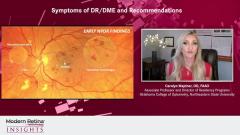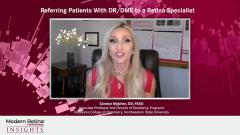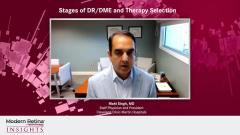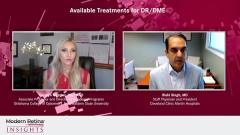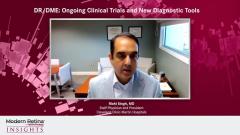
Referring Patients With DR/DME to a Retina Specialist
Carolyn Majcher, OD, FAAO, discusses when to refer patients with diabetic retinopathy and diabetic macular edema (DR/DME) to a retina specialist.
Episodes in this series

Rishi Singh, MD:You mentioned the technology improving and our ability to stage and address patients, but let’s say you have a patient whom you need to now refer. What does that mean to you? What level of retinopathy makes you refer a patient? At what level of DME [diabetic macular edema] are you referring a patient? And what challenges do you have when you’re interacting with someone like myself, a retina specialist, with regards to treatment?
Carolyn Majcher, OD, FAAO:I’m so glad you asked that question, because it’s very important for optometrists to serve as the gateway to the health care system, to be very knowledgeable regarding which patients can be monitored in-house closely vs which ones need to be referred for consideration of treatment. It is absolutely critical that we as optometric physicians detect patients with severe nonproliferative disease and especially proliferative disease so we can refer them, and they can be treated to preserve vision and reduce the risk of future blindness.
The AOA [American Optometric Association] 2019 Clinical Practice Guidelines are what I follow. They advise that patients with proliferative retinopathy or any degree of macular edema or those with severe nonproliferative retinopathy even in the absence of macular edema be referred to a retina specialist. And the time frame they put on that is 2 to 4 weeks. Furthermore, they recommend that [patients with] eyes that have high-risk proliferative disease be referred to a retina specialist promptly, within 24 to 48 hours, because of that increased risk for severe vision loss or blindness should they be left untreated. Patients with mild to moderate nonproliferative retinopathy typically would only need to be referred should they have macular edema present.
I’d advise my colleagues to consider referral when you’re uncertain as to what the stage of disease is, for whatever reason that may be, but also keep a lookout very closely for anterior segment neovascularization. Neovascularization on the iris or in the angle is something that I feel should be referred very promptly to retina specialists. Sometimes anti-VEGF therapy in that scenario can prevent neovascular glaucoma and prevent tube shunt surgery for a patient if we get on it early and really manage it appropriately.
In terms of challenges we face for patients seeing a retina specialist in a prompt fashion, there are many challenges that patients encounter that may prevent [that]. Some of the most important ones are financial barriers such as insurance coverage or access to care. Many patients needing to see a retina specialist may have reduced vision and therefore rely on transportation services or their friends and family to take them to appointments. Driving long distances every 4 to 6 weeks can be a substantial burden on patients and their caregivers who transport them.
As we are all aware, patients with diabetic retinopathy commonly have other systemic conditions and other complications from diabetes, such as kidney disease, that require them to have frequent dialysis or other medical appointments with subspecialty providers. Patients are forced to juggle all these appointments, which can be a challenge for them to accomplish and prioritize their eye care. For all those reasons, it’s essential that optometric physicians follow up with patients after they’ve made the referral to ensure that they were examined by the retina specialist as the optometric physician recommended.
TRANSCRIPT EDITED FOR CLARITY
Newsletter
Keep your retina practice on the forefront—subscribe for expert analysis and emerging trends in retinal disease management.

